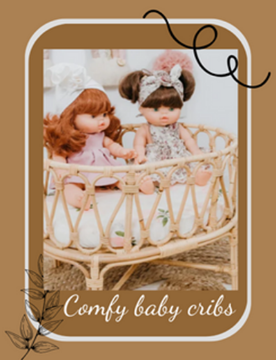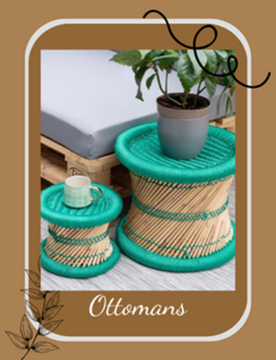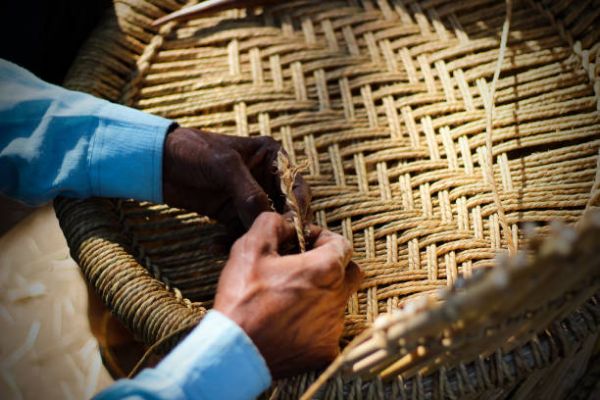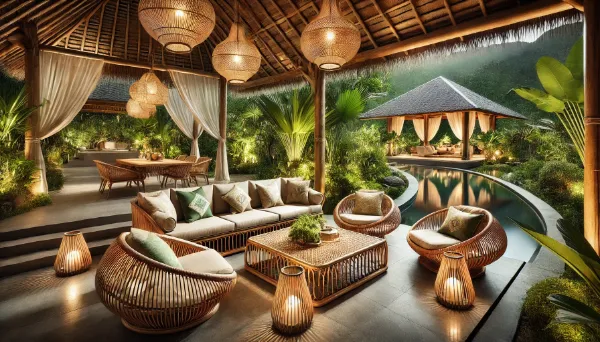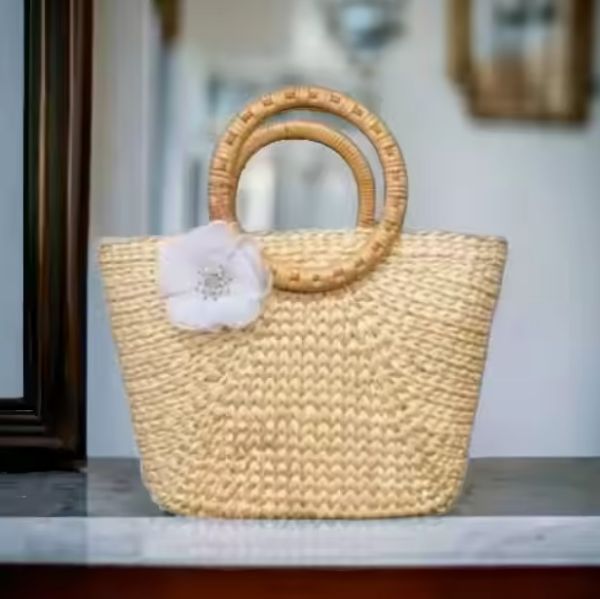Creating the perfect ambiance in your living room requires thoughtful lighting layering, especially when showcasing natural materials like bamboo and rattan furniture. The right lighting can enhance the warm, organic textures of these sustainable pieces while creating a cozy, inviting atmosphere that brings out their natural beauty.
The living room serves as the heart of most homes—a place for relaxation, entertainment, and connection. When you've invested in beautiful bamboo and rattan furniture, proper lighting becomes essential to showcase these eco-friendly statement pieces and create the right atmosphere. Layered lighting isn't just about functionality; it's about creating depth, dimension, and mood in spaces adorned with natural materials.
Bamboo and rattan furniture carry inherent warmth and texture that can be dramatically enhanced or diminished depending on how you light them. The intricate weaving patterns of rattan chairs, the smooth grain of bamboo side tables, and the natural variations in these sustainable materials deserve thoughtful illumination that brings out their best qualities.
In this comprehensive guide, we'll explore professional techniques for layering lighting in living rooms featuring bamboo and rattan furniture, helping you create a space that's both functional and aesthetically pleasing while honoring the natural beauty of these timeless materials.
Understanding the Three Key Lighting Layers
Before diving into specific techniques, let's understand the fundamental layers that make up a well-designed lighting scheme:
Ambient Lighting: Setting the Foundation
Ambient lighting provides the overall illumination for your living room. Think of it as the base layer that ensures you can navigate the space safely and comfortably. For rooms featuring bamboo and rattan furniture, ambient lighting should be warm and gentle to complement these natural materials' inherent warmth.
Best ambient lighting options for bamboo and rattan spaces:
- Ceiling-mounted fixtures with warm-toned LED bulbs
- Recessed lighting with adjustable brightness
- Semi-flush mount fixtures with natural material shades
- Pendant lights with woven or natural material elements
- Wall-mounted sconces that cast a soft, diffused glow
When selecting ambient lighting fixtures, consider designs that incorporate natural materials to echo your bamboo and rattan furniture. Pendant lights with woven bamboo or rattan shades create visual continuity, while fixtures made from other natural materials like wood or linen can complement your existing pieces.
Task Lighting: Functional Illumination
Task lighting focuses on specific activities performed in different areas of your living room, such as reading, working, or playing board games. With the increasing popularity of multi-functional living spaces, proper task lighting has become even more important.
Ideal task lighting solutions for bamboo and rattan living spaces:
- Adjustable floor lamps with rattan or bamboo elements
- Table lamps with natural fiber or woven shades
- Swing arm wall-mounted lamps near reading corners
- Under-cabinet or shelf lighting for display areas
- Directional spotlights for highlighting work surfaces
Task lighting provides an excellent opportunity to incorporate smaller bamboo or rattan elements into your lighting scheme. Consider table lamps with bamboo bases or floor lamps with woven rattan details to create cohesion with your larger furniture pieces.
Accent Lighting: Creating Drama and Focus
Accent lighting is where you can truly showcase the beauty of your bamboo and rattan furniture. This layer adds visual interest, highlights architectural features, and creates focal points within your living room.
Effective accent lighting for bamboo and rattan furniture:
- Strategically placed uplights behind bamboo room dividers
- Small spotlights directed at intricate rattan weaving patterns
- LED strip lights along shelves displaying bamboo accessories
- Picture lights above artwork complementing your natural décor
- Table lamps with directional capabilities to highlight specific furniture pieces
Accent lighting allows you to draw attention to the craftsmanship and detail of your bamboo and rattan pieces. The interplay of light and shadow can enhance the textural qualities of these materials, making them even more visually appealing.
Lighting Placement Strategies for Bamboo and Rattan Living Rooms
Now that we understand the basic layers, let's explore specific placement strategies that work particularly well with bamboo and rattan furniture.
Central Ambient Lighting Considerations
The central ambient lighting in a room with natural material furniture should be thoughtfully selected. Overhead lighting can sometimes cast harsh shadows that flatten the texture of rattan and bamboo. Instead, consider:
- Diffused ceiling fixtures: Look for fixtures with frosted glass or natural fiber diffusers that soften light and reduce harsh shadows.
- Multiple light sources: Instead of a single bright central fixture, use several moderate-brightness sources to create even, shadow-free illumination.
- Indirect lighting: Uplighting toward the ceiling creates a soft reflected light that gently highlights the natural colors and textures of bamboo and rattan.
- Dimmable options: Always install dimmers for ambient lighting to adjust the brightness according to different times of day and activities.
- Smart lighting systems: Consider smart bulbs or systems that allow you to program different lighting scenes appropriate for showcasing your natural material furniture at different times.
A popular trend for living rooms with bamboo and rattan furniture is to use large pendant lights with natural materials as the central fixture. Oversized woven pendants made from bamboo, rattan, jute, or other natural fibers create a striking focal point while providing ambient illumination that complements similar materials in your furniture.
Strategic Task Lighting Placement
Task lighting placement should be practical and aesthetically complementary to your bamboo and rattan furniture arrangements:
- Reading corners: Position floor lamps with adjustable heads behind rattan armchairs or bamboo lounge chairs, ensuring the light falls over the reader's shoulder.
- Conversation areas: Use table lamps on bamboo side tables at roughly eye level when seated to provide flattering light for face-to-face conversations.
- Entertainment centers: Install subtle LED strips behind TV units or media consoles made from bamboo to reduce eye strain and create a pleasant viewing environment.
- Game or hobby areas: Pendant lights hung lower over game tables provide focused illumination without disturbing the overall room ambiance.
- Desk or work spaces: Articulating desk lamps with bamboo elements provide adjustable task lighting for temporary work activities in the living room.
When selecting task lighting, look for fixtures that incorporate natural materials matching or complementing your furniture. A table lamp with a bamboo base and linen shade, for example, will blend more harmoniously with your rattan sofa than a chrome or glass alternative.
Artistic Accent Lighting Techniques
Accent lighting offers the greatest opportunity for creativity and can dramatically enhance the appearance of bamboo and rattan furniture:
- Highlighting textural elements: Position small, directional lights to cast subtle shadows from woven rattan patterns, emphasizing their texture and craftsmanship.
- Backlighting bamboo screens: Place LED strips or small uplights behind bamboo screens or room dividers to create dramatic silhouettes that showcase their architectural qualities.
- Illuminating display shelves: Use small recessed lights or LED strips to illuminate collections of smaller bamboo or rattan accessories displayed on shelves or in cabinets.
- Wall-washing techniques: Install fixtures that cast light evenly across textured walls (particularly those with grasscloth or other natural coverings) to complement bamboo and rattan furniture.
- Spotlighting statement pieces: Use adjustable spotlights to highlight exceptional pieces of bamboo or rattan furniture, such as an intricately woven peacock chair or a sculptural bamboo coffee table.
Remember that bamboo and rattan look particularly beautiful in warm light, so choose bulbs with color temperatures between 2700K-3000K for accent lighting that will enhance their natural golden hues.
Selecting the Right Light Fixtures for Natural Material Spaces
The fixtures themselves should complement your bamboo and rattan furniture both in style and material.
Complementary Materials and Styles
Choose fixtures that echo or complement the materials in your furniture:
- Natural fiber shades: Lampshades made from linen, jute, raffia, or other natural fibers diffuse light beautifully and complement bamboo and rattan furniture.
- Bamboo and rattan fixtures: Light fixtures incorporating the same materials as your furniture create cohesion—consider pendant lights with bamboo frames or table lamps with rattan bases.
- Wooden elements: Fixtures with wooden components often pair beautifully with bamboo furniture, especially if finished in similar tones.
- Handcrafted qualities: Look for fixtures with artisanal qualities that reflect the handcrafted nature of quality bamboo and rattan furniture.
- Organic forms: Choose fixtures with organic shapes and forms that echo the natural origins of your bamboo and rattan pieces.
Size and Scale Considerations
The size and scale of your lighting fixtures should be proportional to your furniture and room dimensions:
- Statement pendants: In rooms with high ceilings, large woven pendant lights can create a dramatic focal point above bamboo coffee tables or rattan seating arrangements.
- Balanced proportions: Ensure table lamps are proportional to the surface they sit on—a delicate bamboo side table pairs better with a smaller lamp than a massive one that overwhelms it.
- Visual weight: Consider the "visual weight" of your fixtures—intricate rattan furniture may pair better with simpler, less visually complex lighting to avoid competition.
- Height variations: Use lighting fixtures at different heights to create visual interest and draw the eye to different areas of your bamboo and rattan furnishings.
- Grouped arrangements: Consider clustering smaller pendant lights rather than using a single large fixture to create interest while maintaining proportion.
A good rule of thumb is that a central pendant or chandelier should have a diameter (in inches) equal to the sum of the room's length and width in feet. For example, in a 10' × 12' room, a 22" diameter light fixture would be appropriately scaled.
Bulb Selection for Enhancing Bamboo and Rattan Furniture
The type of bulbs you choose significantly impacts how your bamboo and rattan furniture appears.
Color Temperature Considerations
Color temperature dramatically affects the appearance of natural materials:
- Warm white (2700K-3000K): These bulbs enhance the golden tones in bamboo and rattan, creating a cozy, inviting atmosphere that showcases their natural warmth.
- Neutral white (3500K-4000K): These can be used in work areas within the living room but may make bamboo and rattan appear slightly cooler and less rich in tone.
- Cool white (5000K+): Generally avoid these with natural materials as they tend to drain the warmth from bamboo and rattan, making them appear flat and lifeless.
- Adjustable temperature bulbs: Consider smart bulbs that allow you to adjust the color temperature according to the time of day or desired mood.
- Consistent temperatures: Ensure all bulbs in visible areas have matching color temperatures to avoid creating jarring transitions across your space.
For most bamboo and rattan-furnished living rooms, warm white bulbs around 2700K-3000K will showcase these materials at their best, highlighting their natural honey tones and rich textures.
Types of Bulbs and Their Effects
Different bulb technologies create different qualities of light:
- LED bulbs: Energy-efficient and long-lasting, modern LEDs come in various color temperatures and can be dimmed. Look for high CRI (Color Rendering Index) LEDs (90+) that accurately render the natural colors of your bamboo and rattan.
- Halogen bulbs: Produce a bright, white light that can beautifully highlight the texture of woven rattan, though they run hotter and use more energy than LEDs.
- Incandescent bulbs: While being phased out in many regions, they provide excellent warm light that complements bamboo and rattan but are energy-inefficient.
- Smart bulbs: Programmable bulbs allow you to adjust brightness, and sometimes color, to create different moods and showcase your natural furniture differently throughout the day.
- Filament LED bulbs: Combine the classic look of vintage filament bulbs with LED efficiency, creating a warm glow that complements natural materials beautifully.
When selecting bulbs, also consider their beam spread. Narrow beam bulbs are excellent for highlighting specific details in your bamboo or rattan furniture, while wide beam bulbs provide more general illumination.
Creative Lighting Approaches for Bamboo and Rattan Features
Beyond the basic layers, consider these creative approaches to illuminate specific bamboo and rattan elements in your living room.
Illuminating Bamboo Screens and Room Dividers
Bamboo screens and room dividers offer unique lighting opportunities:
- Backlighting: Position light sources behind bamboo screens to create dramatic silhouettes and highlight their architectural qualities.
- Integrated lighting: Some contemporary bamboo dividers come with built-in LED elements that transform them into light features themselves.
- Projected patterns: Use directional lights to project the intricate patterns of carved or woven bamboo screens onto nearby walls or ceilings.
- Color-changing options: Smart RGB lights placed behind bamboo screens can create different moods through color changes while showcasing the screen's details.
- Gradual illumination: Create a gradient effect by positioning light sources to illuminate only portions of a bamboo screen, creating visual interest through light transition.
A bamboo screen positioned between living and dining areas, for example, can be beautifully highlighted with small uplights placed on the floor behind it, creating dramatic shadows and turning a functional divider into an artistic lighting feature.
Showcasing Woven Rattan Details
The intricate patterns of woven rattan deserve special lighting consideration:
- Side lighting: Position lights to the side of rattan furniture to cast shadows that emphasize the weaving patterns.
- Spotlighting: Use small, focused spotlights to highlight particularly intricate sections of rattan weaving.
- Moving light: Fans or natural air movement can create subtle, shifting shadows from fixed lights that bring rattan patterns to life.
- Layered approach: Combine ambient light from above with side lighting to create depth in the appearance of woven patterns.
- Seasonal adjustments: Consider how natural light interacts with your rattan furniture throughout the day and in different seasons, adjusting artificial lighting accordingly.
A beautifully woven rattan peacock chair, for instance, can become a stunning focal point when illuminated from several angles, creating depth and dimension that showcases the craftsmanship involved in its creation.
Emphasizing Bamboo Architectural Elements
If your living room features bamboo flooring, ceiling treatments, or structural elements:
- Grazing light: Position wall washers to "graze" along bamboo wall coverings or paneling, highlighting their texture through side lighting.
- Uplighting for ceilings: Use uplights to emphasize bamboo ceiling treatments or exposed bamboo beams.
- Floor-level lighting: Small recessed floor lights can dramatically highlight bamboo flooring or the bases of larger bamboo structural elements.
- Hidden source lighting: Conceal light sources behind architectural features to create a glowing effect that emphasizes bamboo elements without showing the fixtures themselves.
- Daylight integration: Position mirrors strategically to bounce natural daylight onto bamboo architectural features during daytime hours.
A living room with exposed bamboo ceiling beams, for example, can be transformed by installing hidden LED strips along the tops of the beams, casting a soft upward glow that highlights their natural beauty without visible light fixtures.
Seasonal and Day-to-Night Lighting Transitions
Your lighting should be adaptable to different times of day and seasons to best showcase your bamboo and rattan furniture.
Programming Lighting Scenes for Different Times
Consider creating programmable lighting scenes:
- Morning brightness: Brighter, more energetic lighting that works with natural daylight to start the day.
- Afternoon transition: Moderate lighting levels that complement the changing natural light as the day progresses.
- Evening ambiance: Warmer, dimmer settings that enhance the cozy appearance of bamboo and rattan in evening hours.
- Entertainment mode: Brighter task areas with dimmed ambient lighting for watching TV or entertaining guests.
- Nighttime pathway: Subtle lighting that provides safe navigation through the space without being too stimulating before bedtime.
Adapting to Seasonal Light Changes
Your lighting needs will change with the seasons:
- Winter adjustments: During darker winter months, increase overall brightness and perhaps warm the color temperature slightly to counteract the cold, blue natural light.
- Summer settings: In summer, reduce artificial lighting intensity during daylight hours and program later activation times for evening scenes.
- Transitional seasons: Spring and fall often require the most adjustment as natural light changes significantly throughout the day.
- Holiday considerations: Create special lighting scenes that showcase your bamboo and rattan furniture appropriately during holiday gatherings or special occasions.
- Automated adaptations: Consider light sensors or smart systems that automatically adjust to changing natural light conditions throughout the year.
The natural, organic qualities of bamboo and rattan look different under varying light conditions, so your lighting scheme should be flexible enough to showcase them optimally regardless of season or time of day.
Integrating Natural and Artificial Light
The interplay between natural and artificial light is particularly important for spaces featuring natural materials like bamboo and rattan.
Window Treatment Strategies
Your window treatments play a crucial role in light management:
- Filtered natural light: Use sheer curtains or bamboo blinds to filter harsh direct sunlight that might wash out the color of your rattan and bamboo furniture.
- Adjustable options: Install layered window treatments that allow you to adjust natural light throughout the day, such as combining bamboo blinds with light curtains.
- Light-directing treatments: Consider top-down/bottom-up shades that allow natural light to enter from above while maintaining privacy.
- Complementary materials: Choose window treatments made from natural materials that complement your bamboo and rattan furniture—jute, linen, or bamboo blinds create material continuity.
- Strategic positioning: Arrange furniture with consideration for natural light patterns—position delicate antique rattan pieces away from direct sunlight that could cause fading.
Natural light brings out the best in bamboo and rattan during daylight hours, so your artificial lighting scheme should be designed to take over seamlessly as natural light diminishes.
Balancing Daylight and Electric Light
Create a harmonious balance between natural and artificial light:
- Light sensors: Install sensors that gradually increase artificial light levels as natural light decreases.
- Transitional settings: Program "sunset" lighting scenes that activate automatically to maintain consistent illumination as day turns to evening.
- Complementary positioning: Place artificial lights to fill in areas that natural light doesn't reach, creating balanced illumination throughout the day.
- Mimicking natural light: Position artificial lights to roughly correspond with the direction of natural light to maintain consistent shadows and highlights on bamboo and rattan textures.
- Adjustable color temperature: Consider systems that shift from cooler to warmer light as the day progresses, mimicking natural daylight patterns.
A thoughtfully designed system creates a seamless transition between daylight and artificial light, ensuring your bamboo and rattan furniture looks its best at all times of day.
Creating Mood with Lighting and Natural Materials
Beyond functionality, lighting creates atmosphere and mood in spaces with natural materials.
Designing for Relaxation and Comfort
Create a restful atmosphere through lighting choices:
- Indirect glow: Bounce light off walls and ceilings to create a soft, diffused glow that enhances the natural warmth of bamboo and rattan.
- Lower positioning: Position some light sources below eye level (table lamps, floor uplights) to create a cozy, intimate feeling.
- Warm dimming: Use bulbs and fixtures that maintain warmth when dimmed (some LEDs become cooler in appearance at lower brightness).
- Layer reduction: For relaxation, consider using only two of your three lighting layers—perhaps just ambient and accent—at lower intensity levels.
- Fire elements: Complement electric lighting with the natural flicker of candles or a fireplace, which pairs beautifully with natural materials like bamboo and rattan.
The inherent warmth of bamboo and rattan contributes to a relaxing environment, and gentle, warm lighting enhances this quality, making your living room a perfect retreat.
Creating Energy and Focus Areas
For more active zones within the living room:
- Directional brightness: Use more focused, directional lighting in areas designated for activities requiring concentration.
- Higher color temperatures: Consider slightly higher color temperature bulbs (around 3500K) in spaces devoted to hobbies, reading, or other detail-oriented activities.
- Contrast creation: Create greater contrast between light and shadow in activity areas to increase energy and alertness.
- Adjustable options: Install fixtures with adjustable arms or heads to redirect light as needed for different activities.
- Activity highlighting: Use slightly brighter illumination to subtly guide people toward activity areas within the larger living space.
Even in more energetic spaces, maintain some warmth in your lighting to complement the natural qualities of your bamboo and rattan furniture rather than working against them.
Sustainable Lighting Approaches for Eco-Friendly Spaces
Since bamboo and rattan are sustainable, eco-friendly materials, consider extending this philosophy to your lighting choices.
Energy-Efficient Options for Conscious Living
Align your lighting with the sustainable nature of your furniture:
- LED technology: Choose high-efficiency LED fixtures and bulbs that consume minimal energy while providing excellent light quality.
- Solar-powered options: For homes with good sun exposure, consider solar-powered lighting options for table lamps or garden areas visible from the living room.
- Smart controls: Install occupancy sensors, timers, and smart controls to ensure lights are only on when needed.
- Energy Star certification: Look for fixtures with Energy Star certification that meet strict efficiency guidelines.
- Low-voltage systems: Consider low-voltage lighting systems that reduce energy consumption while providing beautiful illumination for your natural furniture.
The combination of sustainable bamboo and rattan furniture with energy-efficient lighting creates a living room that's both environmentally responsible and aesthetically pleasing.
Eco-Friendly Fixture Materials
Extend your commitment to natural materials to your lighting fixtures:
- Biodegradable shades: Choose lampshades made from biodegradable materials like paper, linen, or other natural fibers.
- Reclaimed components: Look for lighting fixtures made from reclaimed or recycled materials that complement your bamboo and rattan furniture.
- Sustainable wood bases: Select lamps with bases made from certified sustainable wood that pairs well with bamboo furniture.
- Natural dyes and finishes: Choose fixtures finished with non-toxic, natural dyes and coatings that maintain indoor air quality.
- Locally made options: Support local artisans creating lighting fixtures from sustainable materials, reducing transportation carbon footprint.
Budget-Friendly Lighting Solutions for Bamboo and Rattan Spaces
Creating beautiful layered lighting for your natural furniture doesn't have to break the bank.
Affordable Options That Don't Compromise Style
Find budget-friendly solutions that still showcase your bamboo and rattan beautifully:
- DIY possibilities: Create your own pendant lights using bamboo baskets or other natural materials as shades.
- Thrift store transformations: Purchase second-hand lamps and update them with new shades made from natural materials.
- Strategic investment: Splurge on one statement piece that complements your bamboo and rattan furniture, while choosing more affordable options for secondary fixtures.
- Phased implementation: Develop your lighting plan in phases, starting with essential ambient and task lighting before adding accent elements over time.
- Replaceable elements: Choose fixtures with replaceable shades so you can update your look affordably as trends change.
Maximum Impact on Minimum Budget
Focus your limited budget for maximum effect:
- Statement centrals: Invest in a striking central pendant with natural elements rather than spreading your budget across many mediocre fixtures.
- DIY accent lighting: Create affordable accent lighting using simple clip lights with warm bulbs positioned to highlight your best bamboo and rattan pieces.
- Upgraded shades: Replace generic lampshades with natural material versions that better complement your furniture—an affordable way to transform existing fixtures.
- Strategic bulb selection: Invest in high-quality bulbs with excellent color rendering, even in basic fixtures, to showcase your natural furniture at its best.
- Focused approach: Rather than trying to light every corner perfectly, focus on creating a few well-lit areas that highlight your best bamboo and rattan pieces.
Remember that the quality of light is more important than the fixture itself—a simple fixture with an excellent bulb can showcase your bamboo and rattan furniture better than an expensive fixture with poor light quality.
Global Styling: Regional Approaches to Bamboo and Rattan Lighting
Bamboo and rattan are used worldwide, with different lighting approaches across various cultures.
Tropical and Southeast Asian Inspirations
Draw inspiration from regions where bamboo and rattan originated:
- Balinese influences: Incorporate dramatic pendant lights with intricate cutouts that cast patterned shadows across rattan furniture.
- Thai-inspired lanterns: Use paper lanterns with bamboo structures to create a soft, diffused light that complements natural furniture.
- Indonesian approaches: Consider copper and brass accents in lighting fixtures that contrast beautifully with the natural tones of bamboo.
- Filipino lighting traditions: Draw inspiration from capiz shell chandeliers that pair wonderfully with lighter-toned bamboo and rattan pieces.
- Vietnamese styling: Look to cylindrical silk lanterns that provide gentle illumination perfect for showcasing the texture of woven rattan.
These approaches celebrate the cultural heritage of bamboo and rattan, creating authentic connections between your furniture and lighting design.
Mediterranean and Coastal Adaptations
Coastal and Mediterranean styles often incorporate natural materials in different ways:
- Greek island simplicity: Use simple white fixtures that contrast with and highlight the texture of darker bamboo and rattan pieces.
- Spanish coastal influences: Incorporate wrought iron lighting fixtures with warm bulbs that complement the warmth of natural rattan.
- Southern Italian approaches: Look to ceramic-based lamps in complementary earth tones that pair beautifully with bamboo furniture.
- Moroccan lanterns: Use metal lanterns with cutout patterns that cast interesting shadows across bamboo and rattan surfaces.
- Coastal natural elements: Incorporate lighting fixtures with shell, rope, or driftwood elements that complement the natural quality of bamboo and rattan.
These regional approaches can be adapted to create unique lighting schemes that showcase your bamboo and rattan furniture while reflecting your personal style and cultural interests.
Troubleshooting Common Lighting Issues with Bamboo and Rattan
Even with careful planning, lighting challenges can arise with natural material furniture.
Addressing Shadows and Dark Spots
Natural materials can sometimes create challenging shadows:
- Fill lighting: Use secondary light sources to fill in shadows created by larger bamboo pieces.
- Bounce techniques: Position lights to bounce off walls or ceilings, creating softer, more diffused illumination that minimizes harsh shadows.
- Multiple angles: Light important pieces from multiple angles to reduce shadowing and show off their full dimensional quality.
- Reflective surfaces: Incorporate mirrors or light-colored surfaces strategically to reflect light into shadowed areas.
- Adjustable solutions: Use adjustable fixtures that can be repositioned as needed to address shadow issues as they arise.
The intricate patterns of woven rattan can create complex shadows; rather than trying to eliminate all shadows, work with them to create interesting visual texture that enhances rather than detracts from your furniture.
Preventing Glare and Hotspots
Avoid uncomfortable glare that detracts from your bamboo and rattan furniture:
- Diffused sources: Use frosted bulbs or fixtures with diffusers to soften light and reduce harsh glare.
- Strategic positioning: Place lights where they won't create direct glare when seated in your primary rattan seating areas.
- Layer balancing: Ensure your ambient layer provides enough general illumination that accent lights don't create jarring bright spots.
- Bulb recessing: Choose fixtures where the bulb is recessed or shielded to prevent direct view of the light source.
- Dimming controls: Install dimmers on all circuits to fine-tune brightness and eliminate hotspots.
Proper positioning is key—make sure lights illuminate your bamboo and rattan furniture without shining directly into the eyes of people using the space.
Lighting for Special Considerations
Some special situations require additional lighting considerations when working with bamboo and rattan furniture.
Lighting for Photography and Social Media
If you frequently photograph your beautifully designed space:
- Color accuracy: Use high CRI bulbs (95+) that render the true colors of your bamboo and rattan furniture for photography.
- Balanced approach: Create even illumination that showcases the texture of natural materials without harsh shadows for better photos.
- Adjustable options: Install fixtures that can be brightened or repositioned when photographing your space for social media.
- Natural daylight simulation: For photography, consider some fixtures with color temperatures around 5000K that can be switched on specifically for photo sessions.
- Highlight positioning: Install adjustable accent lights that can be directed at your best furniture pieces when photographing.
With the popularity of interior design on social media, lighting that photographs well has become increasingly important for showcasing bamboo and rattan furniture online.
Lighting for Aging Eyes and Accessibility
For multi-generational households or aging-in-place considerations:
- Higher illumination levels: Increase overall brightness to accommodate older eyes, which typically need more light to see the same details.
- Glare reduction: Be particularly careful about glare, which can be more problematic for aging eyes.
- Task lighting emphasis: Provide stronger, more focused task lighting in reading areas or other activity spaces.
- Contrast creation: Use lighting to create clear visual contrast between different furniture pieces and pathways through the room.
- Transitional consideration: Avoid abrupt changes between very bright and very dark areas, which can be challenging for older eyes to adjust to.
With thoughtful planning, your lighting can showcase your beautiful bamboo and rattan furniture while accommodating the visual needs of all household members and guests.
DIY Lighting Projects for Bamboo and Rattan Enthusiasts
For those who enjoy crafting, creating custom lighting for your bamboo and rattan space can be rewarding.
Handcrafted Fixtures That Complement Natural Materials
Consider these DIY lighting projects:
- Bamboo pendant shades: Create pendant light shades from bamboo strips or small bamboo blinds formed into cylinders or other shapes.
- Woven basket transformations: Convert woven baskets into pendant light shades by removing the bottom and installing simple light kits.
- Bamboo table lamps: Craft table lamp bases from bamboo poles or bundles, finished with natural oil and paired with simple linen shades.
- Rattan-wrapped fixtures: Wrap simple fixture bases with rattan cane to create cohesion with your furniture.
- Natural material sconces: Create wall sconces using bamboo halves or woven materials combined with simple electrical components.
DIY projects allow you to create one-of-a-kind lighting that perfectly complements your specific bamboo and rattan furniture pieces while expressing your personal creativity.
Upcycling and Repurposing Ideas
Give new life to existing items:
- Thrift store transformations: Refinish thrifted lamp bases in colors that complement your bamboo furniture and add natural fiber shades.
- Bamboo vessel lamps: Convert bamboo vases or containers into lamp bases by adding simple wiring kits.
- Repurposed bamboo elements: Transform bamboo kitchen items, musical instruments, or other objects into unique lighting fixtures.
- Natural material shade updates: Recover old lampshades with natural fabrics, papers, or woven materials that complement your rattan furniture.
- Bamboo wind chime lights: Convert bamboo wind chimes into hanging light fixtures by adding string lights or simple light kits.
Upcycling not only creates unique lighting that complements your bamboo and rattan furniture but also extends your commitment to sustainability.
FAQs About Lighting for Bamboo and Rattan Living Rooms
1. What color temperature works best with bamboo and rattan furniture?
Warm white light with color temperatures between 2700K and 3000K generally works best with bamboo and rattan furniture. These warmer tones enhance the natural golden hues and rich textures of these materials, creating a cozy, inviting atmosphere. Cooler light (above 4000K) tends to wash out the warmth of bamboo and rattan, making them appear flat and less vibrant. For versatility, consider smart bulbs that allow you to adjust color temperature throughout the day—warmer in evenings and slightly cooler during daytime activities requiring more focus.
2. How can I prevent my lighting from causing bamboo and rattan furniture to fade?
To prevent fading of your bamboo and rattan furniture, take these precautions: First, position furniture away from direct sunlight by using window treatments like UV-filtering films, blinds, or curtains. Second, avoid placing intense task or accent lights too close to natural furniture pieces, as concentrated artificial light can also cause fading over time. Third, consider using LED lighting, which emits minimal UV radiation compared to other light sources. Fourth, rotate furniture periodically to ensure even exposure. Finally, apply UV-protective finishes specifically designed for bamboo and rattan to provide an additional layer of protection against both natural and artificial light damage.
3. What lighting fixtures best complement the natural aesthetic of bamboo and rattan?
The most complementary lighting fixtures for bamboo and rattan interiors incorporate natural materials and organic forms. Consider woven pendant lights made from bamboo, rattan, jute, or seagrass that echo the textures in your furniture. Table lamps with bamboo, wood, or ceramic bases paired with natural fiber shades create visual continuity. Wall sconces with paper, linen, or other natural material diffusers provide soft illumination that flatters rattan textures.
Conclusion
Layered lighting transforms a bamboo and rattan-furnished living room from merely functional to truly extraordinary. By thoughtfully combining ambient, task, and accent lighting, you create depth and dimension that highlights the natural beauty, intricate textures, and warm tones of these sustainable materials. The right lighting approach enhances not just the visual appeal of these pieces but also creates an inviting atmosphere that complements their organic nature.
Remember that lighting is both art and science—experiment with different combinations until you find what works best for your specific space and furniture. Consider how light interacts with your bamboo and rattan throughout the day and across seasons, adjusting accordingly.
By investing time in creating a well-designed lighting plan, you'll not only showcase your beautiful sustainable furniture at its best but also create a living space that feels harmonious, welcoming, and perfectly illuminated for both everyday living and special occasions.

